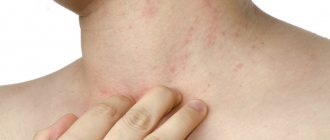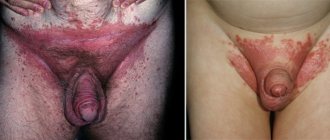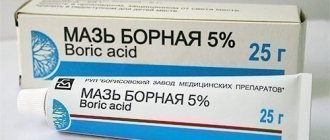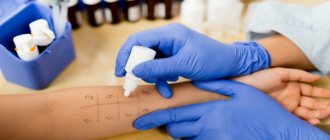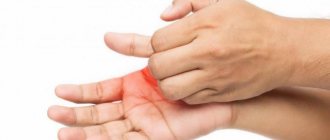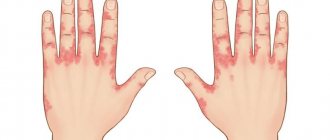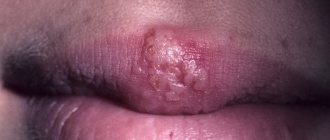Treatment of dermatitis on the hands with folk remedies
The disease is a type of allergy. Dermatologists say that inflammation of the skin on the hands can occur in any person without visible preconditions. According to the method of influence, factors are usually divided into external and internal. External causes of dermatitis on the hands:
- Chemical - rashes are caused by detergents, paints, washing powders, alkalis, acids or cosmetics.
- Physical - dermatosis begins due to low or high temperatures, friction, damage.
- Biological – irritation occurs after inhaling pollen from trees and flowers.
Sometimes irritants enter the body through food and medications, causing irritation. In addition, there are other reasons, these include:
- Hereditary – the patient has a genetic predisposition to allergies.
- Immunological - the rash is a reaction to a weakening of the body's defense system.
- Psychological - the rash is caused by severe nervous tension, depression.
To properly treat dermatitis on the hands, the doctor assesses the external condition of the inflammatory foci. If the disease has not progressed from the initial stage to acute, then you can limit yourself to external creams. However, it is necessary to determine the possible cause of skin irritation. This will help avoid recurrence and transition to a chronic form. In other cases, complex therapy methods are chosen.
A remedy for dermatitis on the hands, containing antibacterial and antiseptic substances, helps well against rashes. It relieves burning and itching, promotes rapid healing of wounds. This list includes ointments:
- Bepanten, Panthenol, Pantoderm, Depanthenol contain the substance dexpanthenol.
- Belosalik – relieves swelling and allergic reactions. Contains salicylic acid, betamethasone.
- Exoderil in the form of an ointment helps with the development of hand fungus. The active ingredient is naftifine hydrochloride.
- Fenistil gel - used as an ointment for rashes on the hands. Helps locally relieve allergies, redness, pain. Contains dimethindene.
- Lokoid is a local decongestant. Includes the active substance hydrocortisone.
- Claritin - has a good antihistamine effect. Composition: loratadine.
- Celestoderm – relieves itching and burning. Includes betamethasone.
- Cetrin – the main effect is exerted by the drug cetirizine.
- Tavegil is the active ingredient of clemastine.
- Triderm - combines allergy drugs clotrimazole, betamethasone, gentamicin.
- Gistan is a hormonal cream for dermatitis on the hands. Contains the glucocorticosteroid mometasone.
Local remedies alone are not enough to completely cure the disease. Doctors advise the patient to completely reconsider his lifestyle. To do this, they suggest treating dermatitis on the hands comprehensively. Proper treatment and prevention consists of:
- Medications. This group includes sedative, immunomodulatory, antiallergic drugs for oral administration.
- A special diet in which smoked foods, too salty and sweet foods are prohibited. Their place should be taken by vegetables and fruits rich in fiber and vitamin C.
- A correct daily routine, when you allocate at least 8 hours a day for sleep.
- Hardening. This measure helps strengthen the immune system to prevent relapses of the disease.
For treatment at home, folk remedies for dermatitis on the hands are suitable. Herbal formulations with ingredients that have a calming, anti-inflammatory effect will help get rid of the disease:
- A decoction of string and chamomile. 4 tbsp. the collection is poured with boiling water, the cooled mixture is wiped over the inflamed area.
- Compress made from cucumber, potato or pumpkin juice. One or more components are rubbed with a fine grater and then applied for 5-7 minutes.
- Ointment with valerian, golden mustache. 1 tsp Mix golden mustache juice with the same amount of valerian decoction, baby cream, olive oil. Apply 2-3 times/day.
In modern medicine, no single cause is known that provokes the disease. However, experts were able to identify the main factors that contribute to the development of the disease.
| Group of stimuli | Main allergens |
| Physical | The disease occurs due to the impact of clothing on the skin (friction, pressure). Sudden temperature changes also provoke pathology. |
| Biological | This can be dust, pollen and plant sap. Often an allergic reaction occurs in the spring, when the active flowering period begins. |
| Chemical | Household chemicals often cause dermatitis:
|
| Products | The most common allergens include:
|
| Ecology | If a person lives in regions where industrial zones are located and the air is polluted by vehicle exhaust gases, the risk of developing the disease increases significantly. |
| Medicines | Any medications, if used incorrectly or over a long period of time, cause allergic reactions. Often this is:
|
| Cosmetics | Allergies are caused by the use of:
|
Quite often the disease can be triggered by:
- autoimmune condition;
- chronic disease (often of the endocrine and digestive systems);
- genetic predisposition;
- serious psycho-emotional shocks;
- hormonal imbalances;
- weakening of the immune system.
What causes the disease? Dermatosis is an allergy to external irritants.
The main types of irritants include:
- Dermatitis on the hands
Physical (humidity, temperature changes, pressure, various types of radiation); - Biological (plants – spurge, ash, nettle, garlic);
- Chemicals (varnishes, paints, acids, household cleaners);
- Obligate (contribute to the occurrence of pathology on the skin, are not biological).
The list of other types of irritants includes:
- Transmitted by airborne droplets (poisonous and toxic substances, plant pollen);
- Cosmetics (hand and body skin care products);
- Food (sweets, dairy products, berries, dyes, preservatives);
- Psychological (excessive emotionality, increased sense of fear, depression);
- Medicines (antibiotics, dietary supplements).
Skin irritation is also associated with heredity. This is the main reason for the occurrence of dermatitis.
Other factors only trigger the mechanism of an allergic reaction on sensitive skin.
Treatment of dermatitis is required only under the supervision of a doctor. Self-medication is unacceptable under any circumstances!
Only after examination and identification of the causes of the disease, the doctor will prescribe the necessary medications for effective treatment.
Most often, drugs are prescribed in the form of ointments and creams.
The most popular and effective include:
- Cream Zorka
Cream “Zorka” (a preparation on a natural basis with a moisturizing, nourishing, regenerating effect). - Antiseptic cream “Eplan” (a drug that restores the skin after damage of various origins);
- De-panthenol cream and its analogues (anti-dryness, copes with cracks, diaper rash, restores skin after burns);
- Cream "Exoderil" (used to treat infectious dermatitis, inflammatory processes);
- Ointment "Radevit" (a remedy for the treatment of inflammation and itching, eliminates cracks in the skin, irritation)
- Dietary supplement “Gistan” (a drug on a natural basis, used in the treatment of skin inflammation);
- Cream "Elidel" (medicine to eliminate inflammation);
- Gel "Fenistil" (a remedy for eliminating itching and relieving pain);
Gel Fenistil
- Ointment "Losterin" (a drug for the treatment of dermatitis and its symptoms - itching, inflammation, pain, fungus);
- Desitin cream (the medicine quickly restores the skin and relieves pain);
- Cream "Wundehil" (a medicine on a natural basis, has anti-inflammatory effects, quickly heals wounds, eliminates fungus);
- Shampoo La-Cri
Ointment "La-Cri" (a product for moisturizing the skin, quickly restores, effectively fights the manifestations of the disease); - Cream "Skin-Cap" (a drug for getting rid of fungus and microbes, fights inflammation and swelling of the skin);
- Ointments "Solcoseryl" and "Actovegil" (medicines for the treatment of chronic and acute stages of dermatitis);
- Cream "Isis" (medicine to eliminate inflammation, fungus);
- Videstim ointment (a drug for rapid restoration and moisturizing of the skin).
The same cannot be said about hormonal medications.
Their use for dermatitis should be careful:
- Celestoderm ointment (a product based on glucocorticosteroids, cures radiation and contact dermatitis on the hands, including seborrheic).
- Advantan ointment (the drug is used against the occurrence of dermatitis on adult and children's skin, including in the presence of skin hypersensitivity).
- Flucinar ointment (the product is used to get rid of dry dermatitis, not caused by infections, with complications in the form of inflammation).
Flucinar ointment
- Flucicort gel (the drug is used against infectious dermatitis);
- Akriderm ointment (the product fights allergies, as well as types of disease not associated with an allergic reaction).
The disease can be eliminated using alternative methods, but at an early stage of the pathological process. Treatment of dermatitis is successful if the foci of pathology are regularly treated with decoctions of chamomile, stinging nettle, and string. The composition is prepared using the classic method - 1 tbsp. l. raw materials per glass of water, but the amount of the finished medicine depends on the abundance of foci of pathology. An adult should perform home procedures daily, supplementing them with official methods.
Treatment
The question of how to cure dermatitis on the hands should be discussed with your doctor. Before prescribing a course of therapy, a specialist must clarify the diagnosis and identify the causes that caused the inflammation. If the cause is an allergy, then it is necessary to identify the substances that provoke the development of an exacerbation.
Advice! To identify a range of allergens, a number of special tests are carried out. The specialist works with skin tests by attaching self-adhesive strips to the skin, on which the most common allergens are applied. You can do this test yourself.
After the diagnosis is established, a course of therapy is prescribed. This disease is treated comprehensively, using local and systemic medications, as well as physiotherapy. In addition, the patient receives recommendations on lifestyle and nutrition changes.
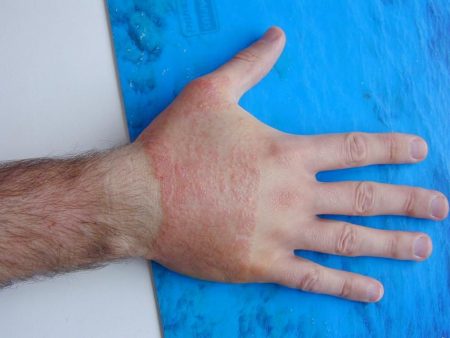
In case of allergic and contact forms of the disease, it is very important to exclude interaction with the allergen. If it is impossible to exclude contacts, you need to minimize their harm. For example, use gloves when working with substances that can cause inflammation. An approximate scheme used in the treatment of dermatitis on the hands:
- The use of external medications - ointments and creams. Anti-inflammatory drugs are used. To treat an adult, products containing synthetic hormones can be used. They are trying to use safer medications for children.
- For the allergic form of the disease, antihistamine tablets are prescribed; they relieve itching well and stop the inflammatory process.
- Following a hypoallergenic diet.
- General strengthening measures - vitamin therapy, hardening procedures, moderate physical activity.
Folk remedies
How to treat dermatitis on the hands at home? This disease has long been treated with folk remedies. However, for dermatitis on the hands, treatment using traditional medicine is recommended as an addition to the main treatment.
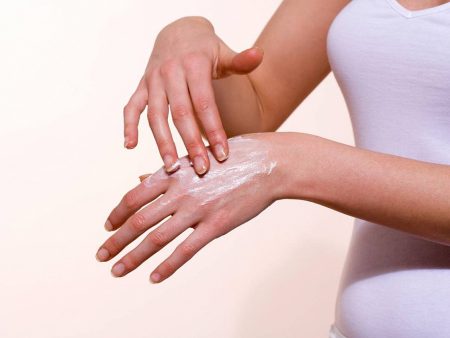
At home, it is recommended to treat skin pathologies with herbal baths. Decoctions of chamomile and string are especially effective; these herbs can be used individually or in combination. Hands are immersed in the warm broth and left for a quarter of an hour. This simple procedure has cured dermatitis in many people, as the herbal decoction effectively relieves irritation and inflammation.
When treating allergic dermatitis at home, the treatment should be chosen with extreme caution. Since herbs can provoke an exacerbation of the inflammatory process. Therefore, you should use a hypoallergenic product.
Thus, the most famous home remedy for relieving itching from dermatitis is the juice of fresh cucumber or raw potato. Freshly prepared juices are used for a course of lotions. If you are not allergic to bee products, use folk remedies such as compresses made from chalk water, as well as lotions with an aqueous solution of propolis.
The question of how to get rid of dermatitis on the hands worries many people, since this skin disease is common. Inflammation can be triggered by external influences, as well as internal problems, in particular allergies. Treatment is prescribed individually, taking into account the indications, type of disease, and the age of the patient. The use of folk remedies is not excluded, but only as an addition to the main therapy.
Symptoms of dermatitis
Hand skin diseases are characterized by the following manifestations:
- The appearance of red-pink (pink) spots at the site of the lesion;
- The occurrence of swelling with a strong or weak degree;
- If treatment is not treated in a timely manner, blisters may appear containing clear (turbid) liquid or serous contents;
- In place of the burst bubbles, erosion zones appear;
- During an allergic reaction, the skin thickens;
- The appearance of cracks, dryness, keratinized areas on the top layer of skin;
- The appearance of abrasions, swelling;
- The skin on the affected areas becomes too sensitive or, conversely, sensitivity disappears;
- Damaged areas of the skin acquire a bluish tint.
If you are regularly exposed to irritants or treated incorrectly, complications may occur in the form of death of skin tissue, destruction of tissue in deeper layers, and the spread of infection, viruses, and fungi. Untimely treatment of dermatitis threatens the occurrence of diseases such as eczema and sepsis.
Sepsis
What dermatitis on the hand looks like in its symptoms can be seen in the photo. All inflammatory processes on adult and children's skin are treated with special topical medications.
Preparations for internal use
Thus, tableted antihistamines are prescribed to inhibit inflammatory processes and reduce the harmful effects of allergens. Depending on the degree of damage, drugs are prescribed for a period of 2 weeks to several months. To treat dermatitis on the hands, products of various generations are used.
First generation antihistamines (diphenhydramine, mebhydrolin, chloropyramine, clemastine, cyprohepadine, promethazine, quifenadine) have a powerful antipruritic and decongestant effect, and also reduce muscle tone and cause drowsiness. They are recommended for therapy in the acute period.
Second-generation drugs have virtually no effect on the nervous system and do not reduce physical activity, but can negatively affect the functioning of the heart, so they should not be taken by people with cardiac diseases and elderly patients. Second generation antiallergic drugs include terfenadine, astemizole, acrivastine, dimethendene, loratadine.
If it is impossible to provide the patient with bed (home) treatment, third generation . They do not affect the functioning of the brain and heart muscle, which means they can be taken by people whose work involves mental activity. Third generation antihistamines on the pharmaceutical market include cetirizine, fexofenadine, desoloratadine, and hifenadine.
Atopic dermatitis on the hands of children
This is one of the most common diseases in children. Its causes are the same as in adults. Often, atopic dermatitis appears on the crook of the arm and fingers. Usually babies encounter this disease in the first year of life. In the future, it will develop exclusively when the body or skin is exposed to any irritants or diseases.
The course of the pathology in a child is practically no different from the disease in adults. There may be differences in the treatment regimen, since milder drugs and their dosages will be selected for the baby. Self-medication is strictly not recommended.
If parents discover the first signs of the disease, they need to consult a doctor to make an accurate diagnosis and choose adequate therapy. Otherwise, there is a high probability of complications developing.
Only a qualified specialist will tell you how to treat atopic dermatitis on the fingers. The therapy is comprehensive. The treatment regimen is selected individually based on the characteristics of the course of the disease and the patient’s well-being. After collecting anamnesis, the doctor selects the most effective and safe methods of therapy.
Typically the treatment regimen includes:
- antihistamines;
- sedatives;
- antibacterial, antiviral, antifungal drugs;
- vitamin complexes, immunomodulators;
- hormonal, non-hormonal local agents;
- baths, compresses with special solutions;
- correction of diet;
- avoiding contact with potential allergens;
- traditional methods.
The best ointments and creams
Local remedies are necessarily used to treat pathologies on the hands. To treat the disease at the acute stage, hormonal ointments are used:
- Hydrocortisone;
- Prednisolone;
- Lorinden;
- Flucinar;
- Celestoderm;
- Dermovate.
In the early stages, non-hormonal agents demonstrate good therapeutic properties:
- Eplan;
- De-panthenol;
- Radevit;
- Elidel;
- Fenistil;
- La-cree;
- Wundehil.
| Compound | Preparation |
| 4 tbsp. l. daisies and strings | Pour boiling water over the herbal mixture and leave for 20 minutes. Then be sure to strain the infusion, cool it, and use it in the form of baths. |
| Fresh potato juice | Squeeze juice from potatoes and use it for compresses three times a day. The duration of one procedure is no more than 20 minutes. Potato juice can be replaced with cucumber or pumpkin juice. |
| Propolis and olive oil (1:4) | Mix both ingredients and place in a water bath. Cook, stirring constantly until a homogeneous consistency is formed. Use the resulting composition as compresses on the affected areas. |
Atopic dermatitis is a common disease that affects any part of the body. It is of a neuro-allergic nature and is prone to constant relapses. Since the disease progresses rapidly, it quickly becomes chronic.
Self-medication can seriously aggravate the problem. When the first symptoms appear, it is important to consult a doctor to receive adequate and timely medical care.
The main symptoms are severe itching, dry skin with the formation of blisters. Atopic dermatitis on the hands is characterized by the formation of small plaques and papules concentrated in the folds of the skin and filled with pus. Often manifests itself as an allergy on the elbows. The photo shows that the skin becomes pale in those areas where there is no inflammation.
What types of dermatitis are there?
Depending on the source of origin, dermatitis is divided into several types:
- Dermatitis between the fingers
Contact - the disease manifests itself where there is direct contact between the skin and the irritant. As soon as the causes begin to be eliminated, the disease subsides. - Atopic - a disease associated with heredity, when the skin of the hands develops a reaction to irritants of a certain category.
- Actinic - the disease manifests itself with constant contact with radio emission and other types of radiation.
- Seasonal – divided into 2 types. Solar lichen - the disease manifests itself with regular contact with ultraviolet rays. Cold eczema - the disease manifests itself in the form of an allergic reaction to frost and is characterized by redness of the skin, roughness and dryness. The dry type of dermatitis is tolerated calmly. It only gets worse in winter.
- Allergic – the disease manifests itself in the form of a reaction to irritants (itching, burning, rash).
Causes
Dermatitis of the hands can manifest itself for a number of reasons, and accordingly, the methods of dealing with the disease will vary. It is curious that 90% of patients experiencing this disease are women. This is due to the fact that representatives of the fair half of humanity have more delicate skin, which reacts more strongly to external irritants.
If we talk about specifics, the underlying factors of dermatitis can be divided into three main groups:
- Physical. These include prolonged exposure to high or low temperatures on the skin, exposure to ultraviolet rays, and mechanical friction. It should be noted that if the effect of physical irritants is neutralized, the skin quickly acquires a healthy appearance.
- Chemical. These factors are typical for housewives and people working in hazardous industries. Here, irritation manifests itself due to prolonged exposure to chemically active components: paints, solvents, detergents. To eliminate the negative impact of aggressive substances, it is necessary to carry out potentially hazardous work wearing protective gloves.
- Biological. In essence, this is the body’s protective reaction to some natural components. This includes pollen and plant sap; in particular, nettle, garlic, buttercup, and spurge can have a negative effect.
In addition, we can identify the following strong allergens that can provoke the development of pathology:
- Food. Here we are talking about personal intolerance to certain types of food products. For example: milk, citrus fruits, red fruits, sweets. This includes food products that contain large amounts of artificial colors, additives and preservatives.
- Bad ecology. Polluted air (a problem in all large cities) is quite capable of leading to the development of dermatitis.
- Medicines. Long-term use of medications, especially dietary supplements and antibiotics, can cause skin irritation.
- Perfumery. Cosmetics of dubious quality are the main irritant that causes dermatitis .
In addition, one should not discount genetic predisposition, decreased immunity, and disruption of the endocrine glands. These are also very common causes of dermatitis.
How does the disease develop on the skin of the hands?
Throughout the illness, the severity of symptoms varies.
Classic signs of developing dermatitis on the hands are:
- The appearance of itching;
- Swelling of the skin;
- Painful sensations;
- Redness on the skin;
- Increased temperature of the affected area.
The initial stage of dermatitis is characterized by inflammation of the skin and a constant feeling of itching. The skin cracks and becomes covered with small scabs. If treatment is not started on time, bright red nodules form on the skin, which over time grow into large plaques.
Plaques on the palm
Externally, the skin looks like cracked glass, accompanied by watery discharge and severe redness of the skin due to dilation of the capillaries.
The acute and chronic stages of contact dermatitis on the fingers and palms are manifested by pronounced symptoms. The acute degree is characterized by the appearance of swelling, redness of the skin, the appearance of blisters with serous contents, and an increase in temperature in the affected area.
Detergents also contribute to the occurrence of dermatitis. With constant contact, an allergic reaction occurs between the fingers in the form of small wounds.
Over time, interdigital wounds in people grow to deep cracks. When bending the fingers, quite severe pain is felt.
Symptoms
The disease manifests itself with a whole range of symptoms:
- pain in the skin, itching and burning;
- the skin turns red;
- erythematous edema of varying intensity develops;
- in severe cases, blisters appear that can be filled with clear or cloudy liquid;
- areas of necrosis also form;
- after the bubbles open, erosions form, which are subsequently covered with crusts and scales.
When the disease becomes chronic, the following symptoms may occur:
- thickening of individual layers of the dermis occurs;
- the skin becomes bluish in color;
- the skin may be very flaky;
- it becomes dry and covered with cracks;
- in the absence of adequate treatment, atrophy of the epidermis begins.
Dermatitis often causes swelling, abrasions, blisters and even calluses to appear on the hands. Cold dermatitis is manifested by severe itching, as well as the formation of reddish-blue swelling. Contact dermatitis on the hands is characterized by a limited affected area. When the irritant is eliminated, the skin quickly recovers.
Dermatitis is an inflammatory process that appears on the skin in response to a particular irritant. It is manifested by the following symptoms:
- Itching;
- The appearance of pimples resembling acne;
- Redness;
- Accumulation of pimples into larger blisters with clear or yellow liquid inside;
- Appearance of cracks;
- Thickening of the skin;
- Swelling and difficulty moving.
Of course, not all symptoms may appear with dermatitis, but even the presence of discomfort and one of the listed signs should make you take a closer look at your skin for some time.
Dermatitis on the hands and fingers usually results in obvious damage to the skin. That is why the clinical manifestations of dermatitis and its process are determined by the concentration, period of exposure and factor of the irritant, while damage to the skin appears quickly or some time after the first contact with the irritant, and the affected area specifically corresponds to the area of this contact.
Each manifestation has its own symptoms. A mild degree practically does not bother a person and can disappear on its own. If a patient seeks help with this form, as a rule, in a matter of days not a trace remains on his body. The average degree does not go away on its own, and urgent consultation with a doctor is necessary, since unpleasant symptoms will bother the person more and more.
Well, if the disease manifests itself acutely, then the person observes severely inflamed areas on his skin with some features confirming that this is dermatitis:
- severe itching of the affected areas of the skin;
- burning and pain;
- swelling;
- pronounced spots on the hands.
If a severe form of dermatitis is present, blisters with liquid may appear, which begin to burst, create erosions and become crusty.
The worst thing is that if you ignore the symptoms, dermatitis becomes chronic, and the swelling that appears will be stagnant. As a result, the layers of the skin thicken and the skin becomes bluish in color. If dermatitis is not treated, it will lead to complete atrophy of the skin.
If a patient has dermatitis on the hands, treatment should be timely. Only by seeking help in time can a person get rid of this problem forever.
Using traditional medicine methods against dermatitis
Redness and rash in adults and children are caused by substances that come into contact with the skin, hence the name of the form of the disease - contact dermatitis on the hands. Among the allergens, dermatologists name:
- cosmetics;
- temperature changes;
- clothes;
- medicinal creams;
- chemicals and detergents.
Often occurs in women who abuse cosmetics. Patients feel a slight itching, then a rash begins to spread in areas of irritation. Gradually, instead of redness, small blisters form, which require medical treatment. This form of dermatitis is most severe in children. A child can scratch the irritated areas and cause an infection.
Gel Fenistil
Flucinar ointment
Dermatitis can be effectively combated using traditional medicine methods.
The following methods have proven themselves to be the best:
- A proven method using a cabbage leaf applied to the affected area. A patch or elastic bandage is used as a fixative. The application is done overnight. Cabbage has long been known for its antimicrobial and anti-inflammatory effects.
- Millennial infusion
An application of carrots or potatoes mixed with honey. Vegetables are grated on a fine grater, applied to the affected area, secured with a tight bandage and left overnight. When using potatoes with honey, the bandage is applied for only two hours to avoid an allergic reaction to honey. - Baths based on medicinal herbs that have an anti-inflammatory effect (St. John's wort, chamomile, oak bark, yarrow, celandine).
- Using yarrow infusion for external and internal use. To do this, you can buy filter bags with grass at the pharmacy or in bulk packaging. One bag or one hundred grams of herb is poured with boiling water and infused for five minutes. The resulting infusion is used for wiping the damaged area, as well as for oral administration twice a day, fifty milligrams.
The most effective preventive measure against dermatitis is the least possible contact with irritants in everyday life.
To do this, you must follow some rules:
- Protect the skin of your hands when working with household chemicals and chemicals,
- Buy cleaning and detergents with a gentle composition, without strong reagents,
- Use products made for children - washing powders, soaps, products for sensitive skin,
- When going outside, especially in frosty weather, always wear gloves or mittens,
- To protect the skin of your hands in the summer, apply a cream with a moisturizing effect,
- Use high quality soap with a moisturizing effect,
- Apply hand cream as often as possible, but at least in the morning and before bed,
- Carry out therapy using yarrow infusion every month for three to five days.
How is dermatitis diagnosed?
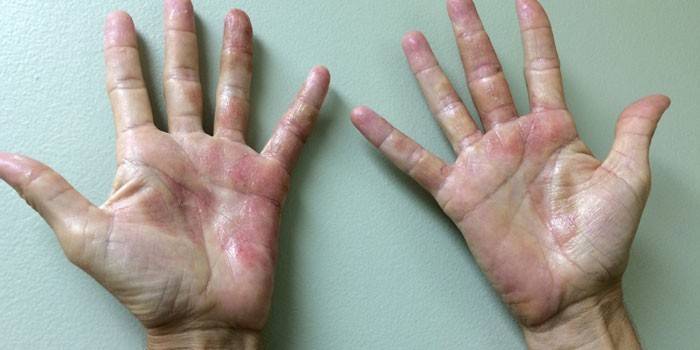
To identify dermatitis and make an accurate diagnosis, you should go to an allergist or dermatovenerologist.
There are cases that do not require examination to establish a diagnosis. It is enough for a professional to conduct a visual examination and ask the patient about contacts with the irritant in order to determine the disease and prescribe appropriate treatment with the exclusion of the irritating factor from everyday life.
If the presence of symptoms of dermatitis raises doubts about the diagnosis, then tests are prescribed.
What tests are prescribed to diagnose dermatitis:
- General detailed tests (blood, urine);
- Tests for the presence of antibodies and antigens (serological, immunological);
- Examination for the presence of cancer cells using histology;
- Blood testing for various manifestations of allergens.
In a child, the signs of dermatitis on the hands and fingers are exactly the same as in adults. The only difference is the reason for its appearance. The main place here is the high sensitivity of children's skin.
In second place are allergic reactions to medications, pollen, and fruit and berry juices.
What does dermatitis on the hands look like?
Each type of irritation looks different in adults. According to the location of redness, they are distinguished:
- dermatitis on the elbows;
- dermatitis on fingers;
- dermatitis on the palms.
The doctor can determine by appearance or photo what type of hand dermatitis is bothering the patient:
- Atopic and allergic look like rashes covering the palms and fingers. If a complication occurs, the skin pattern in the areas of compaction changes.
- Contact appears in places of contact with a possible allergen. Irritation begins from the bend of the arm, between the fingers, and elbows. Reddened areas of the skin appear, small pimples with pus form.
- Seborrheic is associated with a malfunction of the sebaceous glands. The skin looks untidy, then begins to peel and itch. Foci of inflammation covered with a yellowish film crack and bleed.
- Eczematous begins with itching and an increase in local temperature in the inflamed area. The skin turns red and becomes cracked. In some places, bright red papules form.
- Infectious accompanies diseases such as measles, chickenpox, rubella, scarlet fever, and enterovirus infection. It may appear as pimples with purulent blisters on top.

